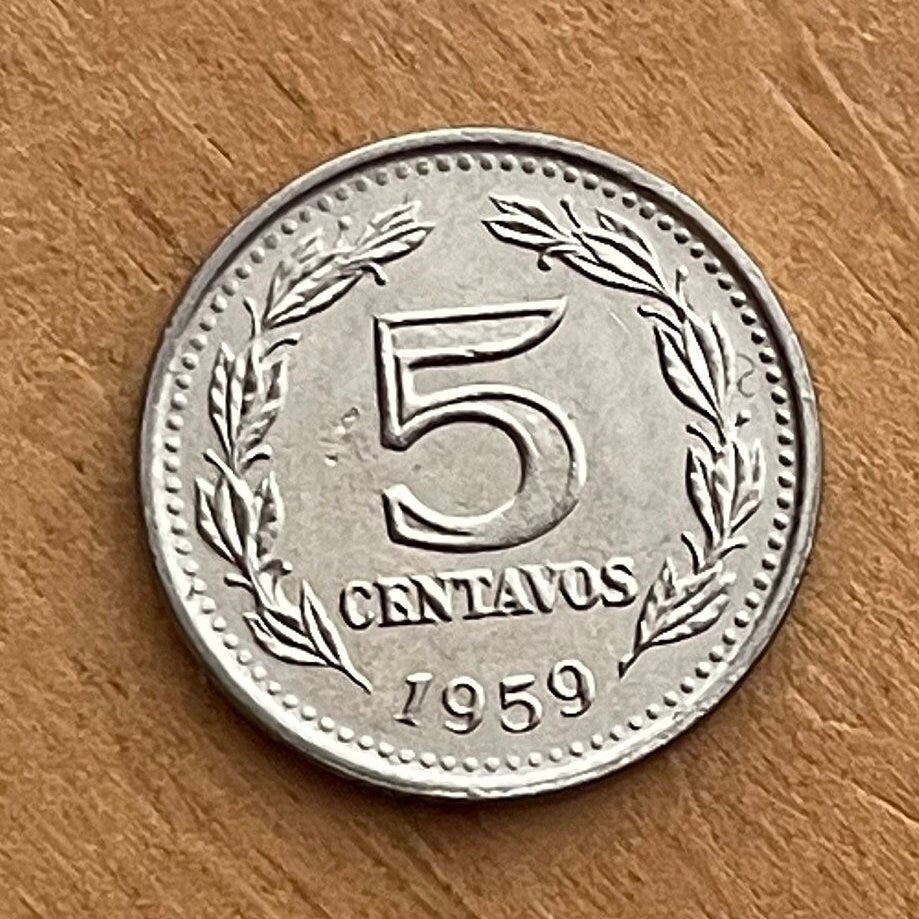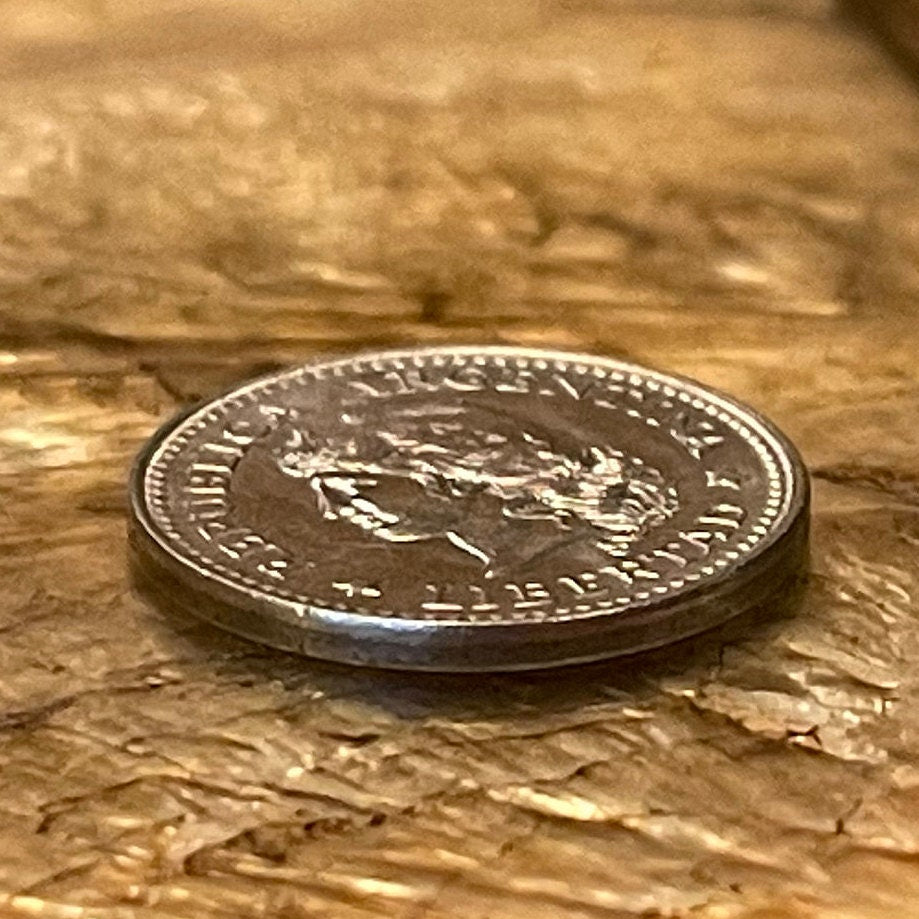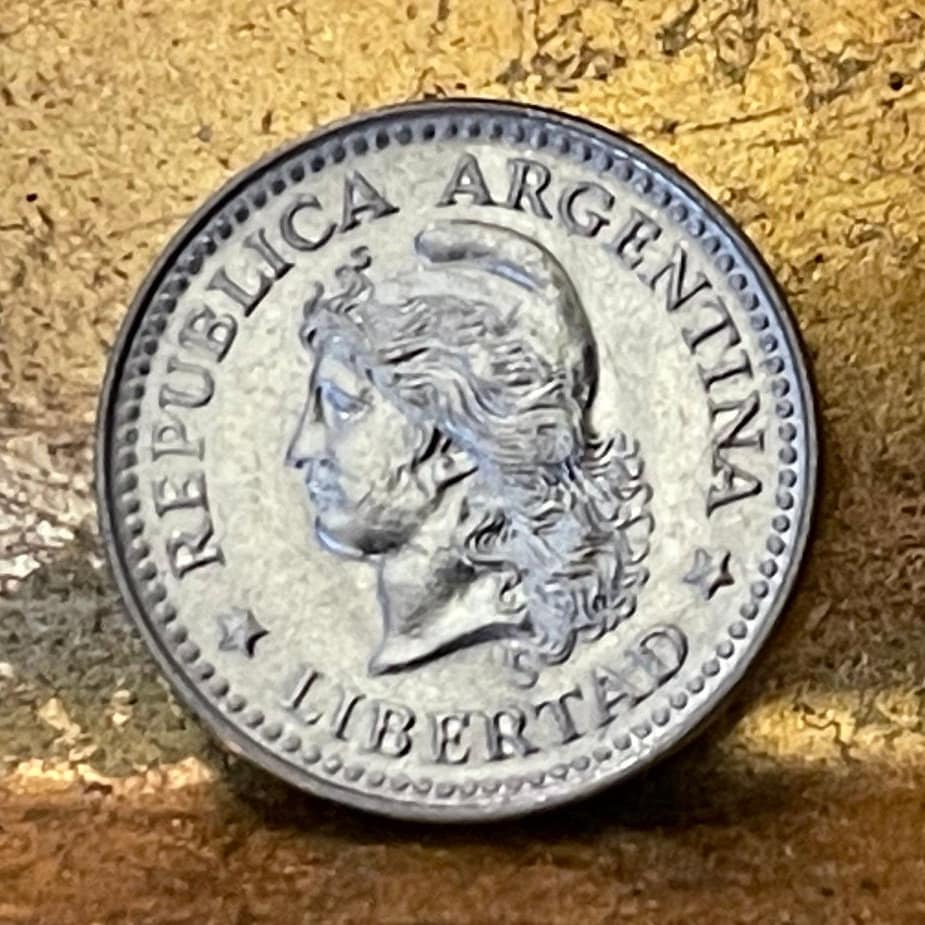elemintalshop
Goddess of Liberty by Oudiné in Phrygian Cap 5 Centavos Argentina Authentic Coin Money for Jewelry and Craft Making
Goddess of Liberty by Oudiné in Phrygian Cap 5 Centavos Argentina Authentic Coin Money for Jewelry and Craft Making
Couldn't load pickup availability
Goddess of Liberty by Oudiné in Phrygian Cap 5 Centavos Argentina Authentic Coin Money for Jewelry and Craft Making
Obverse
Effigy of Liberty by the French artist Eugène André Oudiné, wearing a Phrygian cap.
Lettering: REPUBLICA ARGENTINA
* LIBERTAD *
Translation: Republic of Argentina
* LIBERTY *
Reverse: Value within laurel wreath
Lettering: 5 CENTAVOS
Features
Issuer Argentina
Period Federal Republic (1861-date)
Type Standard circulation coin
Years 1957-1959
Value 5 Centavos (0.05 ARM)
Currency Peso moneda nacional (1881-1969)
Composition Copper-nickel clad steel
Weight 2 g
Diameter 17 mm
Thickness 1.3 mm
Shape Round
Technique Milled
Orientation Coin alignment ↑↓
Demonetized 1 January 1970
Number N# 4568
References KM# 53, Schön# 53, CJ# 271-273
Wikipedia:
One of the most recurrent figures in Argentine currency is the Effigy of Liberty by the French artist Eugène André Oudiné, which shows the profile of a woman with a serene face, abundant hair loose to the wind and a Phrygian cap. Oudiné carved his Effigy of Liberty in 1881, by order of the engineer Eduardo Castilla, first president of the Casa de Moneda, to illustrate the reverse of the coins of the peso moneda nacional, whose creation was enacted that same year to unify the monetary system of country. The Liberty of Oudiné was present in monetary emissions without interruption until 1942, when it was replaced by a modern bust made in 1940 by French sculptor Lucien Bazor. However, it reappears in the emission of 1957, and is present in subsequent designs of peso ley, peso argentino and austral.
A slightly different version appears on the banknotes of fifty cents m$n, in circulation between 1942 and 1960. This effigy can be compared with the design of Oudiné, and considered inspired by Liberty Leading the People. The Liberty of Oudiné also appears in the logo of the Central Bank of Argentina, and the former company Gas del Estado. It is also used in the seals of the Internal Revenue law present in cigarette packs.
*****
Eugène André Oudiné (1810–1887), French sculptor and engraver of medals and coins, was born in Paris on 1 January 1810, and devoted himself from the beginning to the medallist's branch of sculpture, although he also excelled in monumental sculpture and portrait busts.
Life
Having taken the Prix de Rome for engraving in 1831, he had a sensational success with his Wounded Gladiator, which he exhibited in the same year. He subsequently occupied official posts as designer, first to the Inland Revenue Office, and then to the Mint. Among his most famous medals are that struck in commemoration of the annexation of Savoy by France, and that on the occasion of the peace of Villafranca. Other remarkable pieces are The Apotheosis of Napoleon I, The Amnesty, Le Duc d'Orleans, Bertholet, The Universal Exposition, The Second of December, 1851, The Establishment of the Republic, The Battle of Inkermann, and Napoleon's Tomb at the Invalides. For the Hôtel de Ville, Paris he executed fourteen bas-reliefs, which were destroyed in 1871.
Of his monumental works, many are to be seen in public places in and near Paris. In the Tuileries gardens is his group of Daphnis and Hebe; in the Jardin du Luxembourg the Queen Bertha; at the Louvre the Buffon; and in the courtyard of the same palace the Bathsheba. A monument to General Espagne is at the Invalides, and a King Louis VIII at Versailles.
Oudine, who may be considered the father of the modern medal, died in Paris on 12 April 1887.
*********
Wikipedia:
The Phrygian cap (/ˈfrɪdʒ(iː)ən/) or liberty cap is a soft conical cap with the apex bent over, associated in antiquity with several peoples in Eastern Europe and Anatolia, including the Balkans, Dacia and Phrygia, where it originated. In first the American Revolution and then French Revolution, it came to signify freedom and the pursuit of liberty, although Phrygian caps did not originally function as liberty caps. The original cap of liberty was the Roman pileus, the felt cap of manumitted (emancipated) slaves of ancient Rome, which was an attribute of Libertas, the Roman goddess of liberty. In the 16th century, the Roman iconography of liberty was revived in emblem books and numismatic handbooks where the figure of Libertas is usually depicted with a pileus. The most extensive use of a headgear as a symbol of freedom in the first two centuries after the revival of the Roman iconography was made in the Netherlands, where the cap of liberty was adopted in the form of a contemporary hat. In the 18th century, the traditional liberty cap was widely used in English prints, and from 1789 also in French prints; by the early 1790s, it was regularly used in the Phrygian form.
It is used in the coat of arms of certain republics or of republican state institutions in the place where otherwise a crown would be used (in the heraldry of monarchies). It thus came to be identified as a symbol of republican government. A number of national personifications, in particular France's Marianne, are commonly depicted wearing the Phrygian cap.
Share



















